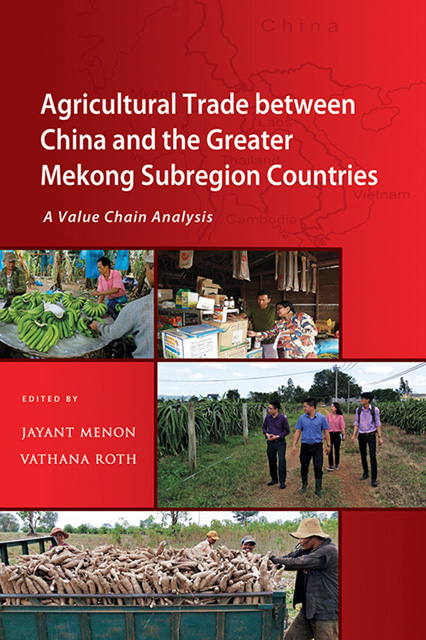Book contents
- Frontmatter
- Contents
- List of Tables
- List of Figures
- List of Annexes
- Foreword
- Preface
- Acknowledgements
- Abbreviations and Acronyms
- The Contributors
- 1 Agricultural Trade between China and the Greater Mekong Subregion Countries: An Overview
- 2 Economic Structural Change in China and the Implications for Agricultural Trade in the Lancang-Mekong Region
- 3 Agricultural Exports from Thailand to China: A Value Chain Analysis of Cassava and Durian
- 4 Agricultural Exports from Cambodia to China: A Value Chain Analysis of Cassava and Sugarcane
- 5 Agricultural Exports from Laos to China: A Value Chain Analysis of Rice and Cavendish Banana
- 6 Agricultural Exports from Myanmar to China: A Value Chain Analysis of Maize
- 7 Agricultural Exports from Vietnam to China: A Value Chain Analysis of Dragon Fruit and Coffee
- Index
5 - Agricultural Exports from Laos to China: A Value Chain Analysis of Rice and Cavendish Banana
Published online by Cambridge University Press: 30 June 2023
- Frontmatter
- Contents
- List of Tables
- List of Figures
- List of Annexes
- Foreword
- Preface
- Acknowledgements
- Abbreviations and Acronyms
- The Contributors
- 1 Agricultural Trade between China and the Greater Mekong Subregion Countries: An Overview
- 2 Economic Structural Change in China and the Implications for Agricultural Trade in the Lancang-Mekong Region
- 3 Agricultural Exports from Thailand to China: A Value Chain Analysis of Cassava and Durian
- 4 Agricultural Exports from Cambodia to China: A Value Chain Analysis of Cassava and Sugarcane
- 5 Agricultural Exports from Laos to China: A Value Chain Analysis of Rice and Cavendish Banana
- 6 Agricultural Exports from Myanmar to China: A Value Chain Analysis of Maize
- 7 Agricultural Exports from Vietnam to China: A Value Chain Analysis of Dragon Fruit and Coffee
- Index
Summary
INTRODUCTION
Agriculture has been recognized as the foundation of the economic development of Laos since the New Economic Mechanism was introduced in 1986. To bring about a significant increase in agricultural production in a sustainable way, the Lao government recently adopted land zoning (at provincial and district levels) for agriculture. As a result, in tandem with the implementation of Agricultural Development Strategy 2016–25, agricultural land has been classified into three zones for specialization in large-scale production for export: plains, agricultural land not classified as plains, and arable land in mountain and plateau areas. The strategy also emphasizes the promotion of domestic and foreign investors in agricultural development, aiming to accelerate the transition from subsistence farming to commercial production of agricultural goods.
Agriculture is central to the Lao economy. The majority of the population live in rural areas where they depend on agriculture for their survival. Agriculture plays a crucial role in daily life, ensuring food and nutrition security and supporting livelihoods, employment and income generation. The promotion of commercial agriculture over the past decades has led to a significant shift in farming practices, from growing food (i.e., subsistence) crops only to cash (i.e., marketed) crops. More recently, growing cash crops for export has been encouraged in many parts of the country. Specifically, MOAF (2011) earmarked six cash crops with export potential and which Laos has comparative advantages in producing; they are rice, bananas, maize, coffee, cassava and sugarcane. The main motivation behind this export-driven strategy is twofold. Integration into regional markets facilitates participation in regional and global agricultural value chains, which is considered essential to boost agricultural productivity, which, in turn, is seen as vital to lift rural people out of poverty.
The six cash crops identified by MOAF grow well in many parts of the country, and large plantations have already been established. These commodities now dominate Laos’ agricultural exports, with most exports going to countries in the Mekong region, notably China, Thailand and Vietnam. Combined, these three countries account for more than threefourths of Laos’ total agricultural trade in terms of volume. Several key factors have influenced Laos’ deeper economic integration in the region. Transportation improvements, particularly better road connectivity, have directly enhanced access to regional markets in more populous countries (ADB 2018).
- Type
- Chapter
- Information
- Agricultural Trade between China and the Greater Mekong Subregion CountriesA Value Chain Analysis, pp. 164 - 204Publisher: ISEAS–Yusof Ishak InstitutePrint publication year: 2022



